Extreme Weather Likely to Increase
Air Date: Week of January 26, 2018
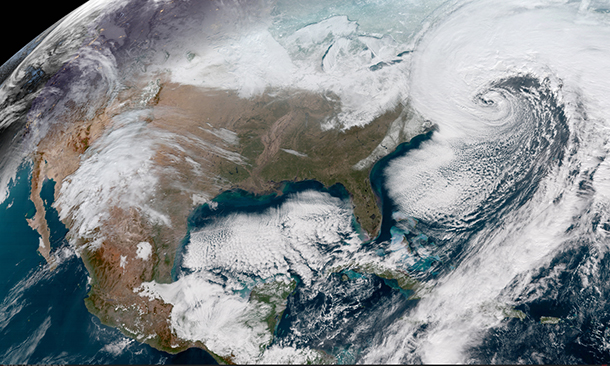
This January 4th Geocolor image from the National Oceanic and Atmospheric Administration (NOAA) GOES-16 satellite captured the record ‘bomb cyclone’ nor’easter that battered the East Coast of the United States in January 2018. (Photo: NOAA)
2017 brought devastating storms and wildfires to the U.S., costing lives and a record $306 billion. Penn State University climate expert Michael Mann tells host Steve Curwood that global warming is making powerful storms and drought driven wildfires more likely. But Professor Mann says this is not a “new normal,” because the planet has not reached a new climate stability. Instead humanity is now facing an ever-increasing threat of unpredictable and extreme weather.
Transcript
CURWOOD: From PRI, and the Jennifer and Ted Stanley Studios at the University of Massachusetts, Boston, this is Living on Earth. I’m Steve Curwood. Extreme weather events are the most likely major threats in 2018, and second only to weapons of mass destruction as risks with the potential of catastrophic impacts. That’s according to a study by the World Economic Forum, released at this year’s conclave in Davos, Switzerland, which, by the way, was disrupted by a record-breaking blizzard. We’ll have more on climate-related risk assessment later in the show, but first for a look at the science behind the dire weather predictions, we turn now to Penn State professor and atmospheric scientist Michael Mann. Michael, welcome back to Living on Earth!
MANN: Thanks. Great to be with you, Steve.
CURWOOD: So, what a lot of people want to know, including me, is: this past year we saw a lot of extreme weather that seems to be connected to the added effects of climate disruption – three killer hurricanes, there were these monster fires, the massive landslides. So, how much of what we saw this past year was just a perfect storm or how close are we to some sort of a new normal, do you think?
MANN: Yeah, well we probably won't be facing a new normal in the sense that a new normal implies that we reach some new sort of equilibrium and that's where things stay, whereas what we're looking at is an ever-shifting baseline. If we continue to emit these warming gases, greenhouse gases, into the atmosphere then the heat waves will become more frequent and more intense – droughts, wildfires, floods. We are seeing a taste of what's in store and there's no question in my mind that in the unprecedented extreme weather that we've seen over the past year, we can see the fingerprint of human influence on our climate.
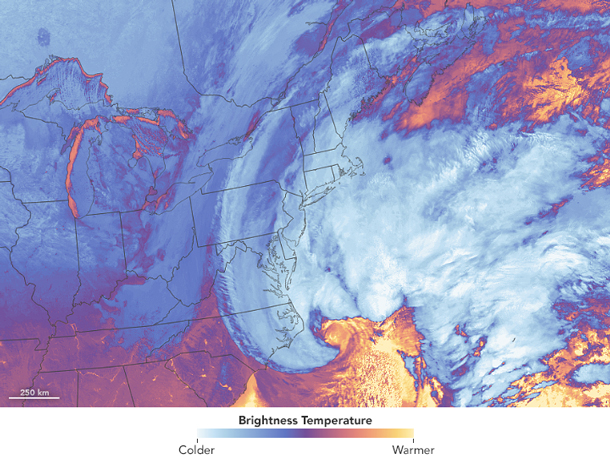
A January 4th NASA image of the record ’bomb cyclone’ nor’easter, showing infrared signals known as brightness temperature. This storm was fueled by warm, moist air rising from the Atlantic crashing into frigid Arctic air. (Photo: Joshua Stevens / NASA)
CURWOOD: I know you're a climate guy and not a weather guy, but looking ahead at 2018, what are the odds that we'll see as many of these really intense events as we saw last year do you think?
MANN: Yeah, sometimes it is difficult to really say where we go from weather to climate because climate change after all is changing the statistics of the weather. It's giving us more of these extreme events and we have every reason to expect that we will see more of that. We long predicted that as the Earth continued to warm, as the oceans warm, there's more energy to intensify hurricanes and to killer storms, there's more moisture in the atmosphere so when it rains it rains harder and you get more of those Harvey-like floods and the floods that California was dealing with just within the past couple weeks – it seems almost paradoxical. But even though the rainfall events become more intense, they become fewer and farther between and so you get more widespread drought, and California is still dealing with an ongoing drought despite the fact that they've had a few very heavy rainfall events.
The wildfires that we've seen on the west coast, again, you bring together extreme heat, extreme drought, you add Pine Bark beetles, which can live through the warmer winters and weaken the forests. All those things come together and to use the term you used previously a "perfect storm" of consequences for wildfire. So, the impacts of climate change are no longer subtle. We are seeing them play out now in the form of these unprecedented events.
CURWOOD: So, I keep wanting to ask you questions outside of your discipline. One is actually an economic one, professor. We saw this last year that there was an enormous amount of financial damage ascribed to these storms. It was north of $300 billion dollars, $306 billion dollars, which is more than the federal government spends on health care and education combined. Looking ahead at this year, I mean, what are the odds we might get hit with a tab like that again do you think?
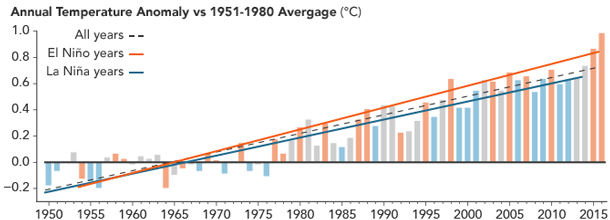
El Niño years tend to be warmer than other years, and global average temperatures are rising overall. (Image: NASA Earth Observatory chart by Joshua Stevens, using data from the Goddard Institute for Space Studies)
MANN: Well, unfortunately, you know, what we're doing is we're loading the dice so that we're favoring those odds, more of those extremely expensive $300 billion dollar seasons are going to occur. Think of them as sixes on the die, and we're seeing more and more of those sixes, and climate change is weighting the die towards those very damaging hurricane seasons, wildfire seasons and it's really important to realize that in the economic toll that climate change is taking – and no, I'm not an economist but some of my best friends are economists and I talk to them – and there is a lot of communication between these different communities – the climate research community, the economics community – because the problems that we deal with, the impacts of climate change and adaptations and the threat of climate change requires us to understand not just the science but the sociology, the economics, the ethics and everything else. And when you look at the economics of climate change, if you talk to the leading economists who study climate change mitigation, they will tell you that the cost of inaction is already far greater than the cost of action, which is to say doing something about the problem, imposing a price on carbon emissions, is a much cheaper option than the option of not doing anything and experiencing more of these devastating $300 billion dollar or greater annual tolls from climate change.
CURWOOD: Right now, how would you characterize the weather conditions in North America. I mean, to what extent is weather acting normal or kind of weird for wintertime?
MANN: Yeah, well we're sort of experiencing weather whiplash right now where we're alternating here in the eastern United States between extreme cold and extreme warmth. Some people look at that, they see the unusual cold and they say, “Well how can there be global warming if we're experiencing unusually cold winter conditions?”, and the fact is that the science is actually pretty nuanced on this point, and even though we expect an overall warming in just about every region of the globe, that doesn't negate the possibility that when we do see these cold waves striking the US that in certain places we could see them strike even harder.
A couple weeks ago we had this unprecedented nor'easter, the strongest nor'easter on record now. It had a central pressure that ranked with many hurricanes in terms of the strength of this storm, but it's not a hurricane, it's an extra tropical storm. Unlike most extra tropical storms, though, these nor'easters gain a lot of their energy from the warmth of the ocean. Even in the winter, the ocean is relatively warm compared to the land, and also all that evaporation and relatively warm ocean water means there's a lot of moisture in those storms and that moisture is converted into massive snowfalls.
So, there's now some emerging science that suggests that warmer oceans like we've seen this season, a very warm Atlantic, when those cold air masses strike the warm oceans and you get those very large differences in temperature and you get all that evaporation from the warm ocean, that, as with a hurricane, leads to in a very intense storm. The more intense that storm, the stronger it's going to be spinning around, and where it's spinning around it's either bringing warm air up on one side or cold air down. The stronger these nor'easters become the more likely it is that we get these episodes of very cold air from the north crashing down into the interior of the United States. Yes, giving us increased cold extremes. So, it is indeed possible that we can see zero overall warming, but bigger extremes on both sides.
CURWOOD: Let's look at last year for a moment. How might those extreme weather events in 2017 have been related to the El Niño, La Niña cycle, if at all?
MANN: Part of what we're seeing, the wacky weather that we're seeing, stronger nor'easters, climate change is probably favoring those patterns in giving us some of the wacky weather that we're seeing, but on top of that the wildcard is of course, El Niño and La Niña, a natural oscillation in the climate system that also influences North American weather patterns in the winter. And detangling all of that is difficult because we think that the impact of El Niño on North America in the winter may itself be changing because of climate change, becoming less predictable.
So, in an El Niño year you would normally see a relatively wet Southwestern US, a dry Pacific Northwest, a relatively warm northern United States and a cool and potentially wet Southeastern United States. And a La Niña year, which is what we're sort of in this year, a weak La Niña, tends to be dry on the west coast, tends to be actually warm in the southeastern US. Well, that doesn't really fit the pattern of what we're seeing this winter. So, El Niño and La Niña may be having an impact, but that impact may be becoming more and more irregular and it sits on top of these other impacts that we think climate change is having.
CURWOOD: You scientists have talked about other oscillations in the weather system. I've heard about the Pacific decadal oscillation, oscillation as a weather flipping back and forth over the course of a decade. What's the thinking about that phenomenon these days?
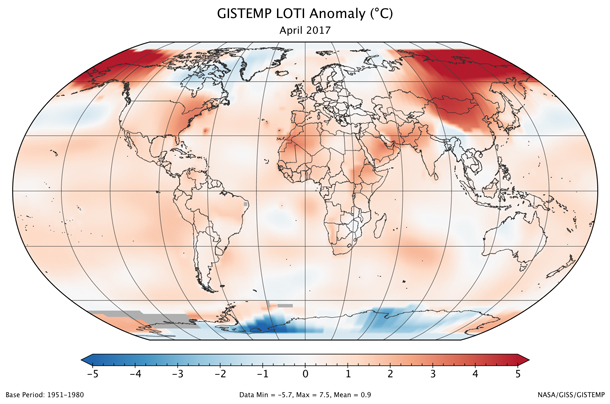
Global temperature anomaly compared to 1951-1980 base period. (Photo: NASA Goddard Institute for Space Studies)
MANN: So, there's still a fair amount of debate about this phenomenon, the so-called Pacific decadal oscillation. We already talked about El Niño, and El Niño is sort of this interannual oscillation. It takes place in time scales of three, four, five years. Well, there is sort of a longer term oscillation in that same system, the tropical Pacific Ocean and atmosphere can also interact on timescales that are a decade or longer. And that means you can have longer term regimes where the climate is more El Niño-like and longer term regimes a decade or more where it's relatively La Niña-like. In fact, we think that some of why the globe didn't warm as much as we expected during the first decade of this century, the 2000 to 2010 or so, it's sometimes been called the “pause” in warming or the “hiatus.” Well, that isn't really a good description as global warming continued. But what is true is the tropical Pacific sort of went into a cool phase for a little while, part of that Pacific decadal oscillation that did offset some of the global warming during that period.
The problem with an oscillation is if you live by the oscillation, you die by the oscillation. Now we may be seeing the flip side of that with an even greater rate of warming over this decade as that phenomenon maybe has flipped into a different phase. But it's really difficult to determine how much of that variation is just a simple internal oscillation in the system and how much of it has to do with the fact that there is an irregular pattern of volcanic eruptions and solar output varies on sort of the decadal time scale as well, and there are human impacts, greenhouse gases, but also pollutants that can have a cooling impact in some regions. All of this is happening at the same time. It's very difficult to detangle it all.
CURWOOD: Michael, this is a time when there's been a lot of pressure on federal research into climate disruption, the science side as well as taking action on the political side. What kind of risk does this put us at if we don't understand this more scientifically, if we don't address it politically?
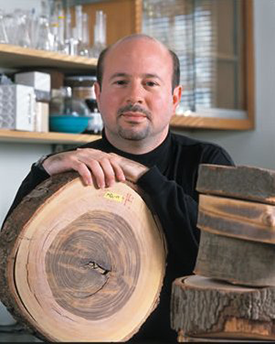
Michael Mann is Distinguished Professor of Atmospheric Science at Penn State University. (Photo: Penn State University)
MANN: Well, the risk simply mounts as we continue to not act to the extent that we need to and there's some progress taking place, and the Paris Accord was a major step forward, but right now here in the United States, we don't have sort of the support at the executive level that we'd like to see for climate action and the risks are clear. They're not subtle any more. We're seeing them play out, $300 billion dollars in extreme weather and climate-related damage this last year that had the fingerprint of human impact on climate.
It doesn't stop there. If we continue not to act then the damages accrue. Pretty soon we commit to the melting of much of the Greenland ice sheet and the West Antarctic Ice Sheet and sea level that thus far had been limited to less than a foot starts to become measured in feet and then pretty soon in meters and yards. So, there isn't a new normal. Things get continually worse if we go down this highway. What we need to do is to take the earliest exit ramp that we can in the form of decreasing our emissions, transitioning from fossil fuels to renewable energy.
CURWOOD: Michael Mann is a Distinguished Professor of Atmospheric Science and Director of the Earth Systems Science Center at Penn State University. Thanks so much, professor, for taking the time with us today.
MANN: Thank you, Steve, always a pleasure.
Links
Living on Earth wants to hear from you!
Living on Earth
62 Calef Highway, Suite 212
Lee, NH 03861
Telephone: 617-287-4121
E-mail: comments@loe.org
Newsletter [Click here]
Donate to Living on Earth!
Living on Earth is an independent media program and relies entirely on contributions from listeners and institutions supporting public service. Please donate now to preserve an independent environmental voice.
NewsletterLiving on Earth offers a weekly delivery of the show's rundown to your mailbox. Sign up for our newsletter today!
 Sailors For The Sea: Be the change you want to sea.
Sailors For The Sea: Be the change you want to sea.
 The Grantham Foundation for the Protection of the Environment: Committed to protecting and improving the health of the global environment.
The Grantham Foundation for the Protection of the Environment: Committed to protecting and improving the health of the global environment.
 Contribute to Living on Earth and receive, as our gift to you, an archival print of one of Mark Seth Lender's extraordinary wildlife photographs. Follow the link to see Mark's current collection of photographs.
Contribute to Living on Earth and receive, as our gift to you, an archival print of one of Mark Seth Lender's extraordinary wildlife photographs. Follow the link to see Mark's current collection of photographs.
 Buy a signed copy of Mark Seth Lender's book Smeagull the Seagull & support Living on Earth
Buy a signed copy of Mark Seth Lender's book Smeagull the Seagull & support Living on Earth

